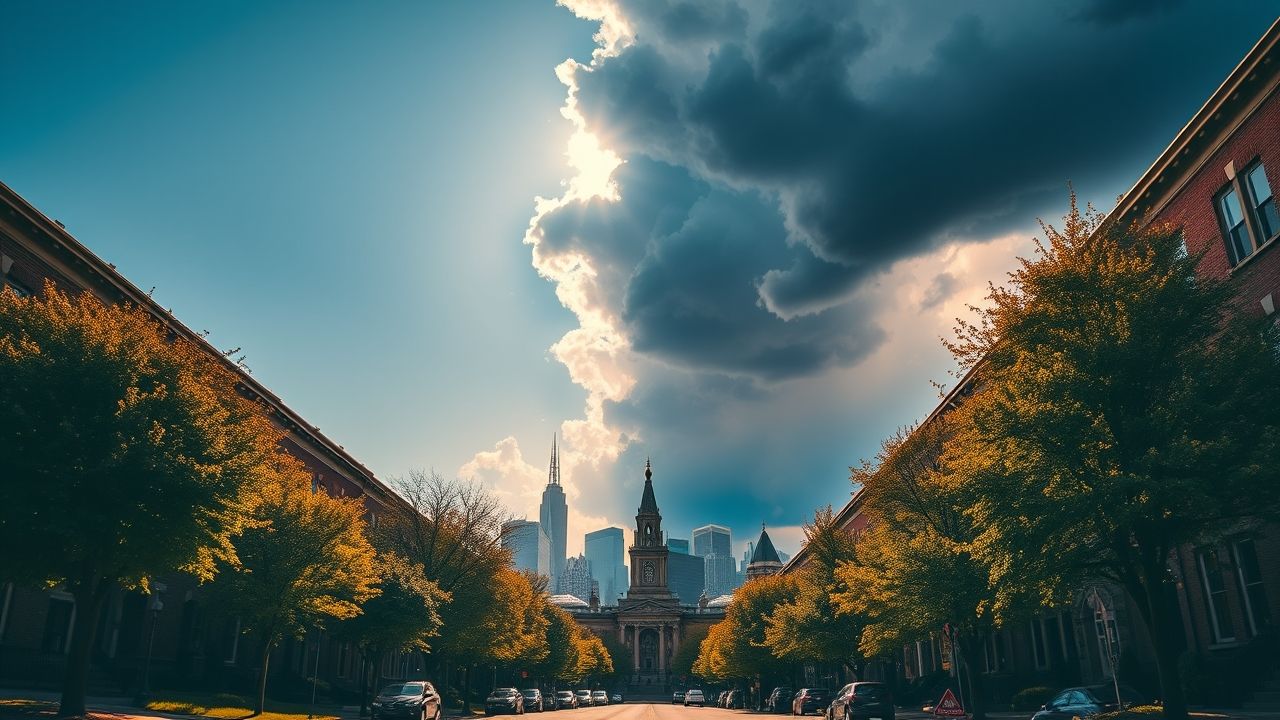There’s a saying in Philadelphia: “If you don’t like the weather, just wait five minutes.” While a slight exaggeration, it perfectly captures the dynamic and often unpredictable nature of philadelphia weather. As a lifelong resident and someone who’s spent years documenting the pulse of this city, I’ve learned that understanding our local climate isn’t just about reading a forecast; it’s about anticipating the rhythm of a place shaped by its unique geographical position. From scorching summer days to unexpected blizzards, Philadelphia offers a full spectrum of meteorological experiences that impact everything from our daily commute to our cherished outdoor festivals.
Key Summary:
- Philadelphia experiences distinct four-season weather, often with rapid transitions between them.
- Summers are typically hot and humid, while winters can be cold with significant snowfall variability.
- The city is susceptible to various extreme weather events, including intense thunderstorms, heatwaves, and coastal flooding.
- Local residents have developed unique and resilient strategies to adapt to the city’s diverse and often challenging climate.
- Common misconceptions about the severity and predictability of the region’s weather often overshadow the nuanced reality.
Why This Story Matters
Understanding philadelphia weather goes beyond mere curiosity; it’s an absolutely crucial aspect of daily life, urban planning, and economic stability in our city. From the critical decision to close schools during an unexpected snowstorm to the immense demand placed on our energy grids during a protracted heatwave, our climate directly influences public services, local businesses, and the fundamental well-being of every resident. The far-reaching impact of weather extends to everything from the agricultural output in surrounding regions that feeds our markets to the precise scheduling of major events along the iconic Delaware River waterfront. For anyone living in, working in, or even just planning a visit to Philadelphia, a robust grasp of our complex weather patterns is not merely helpful; it’s essential for navigating the city effectively, safely, and truly experiencing it like a local.
Understanding Philadelphia Weather Patterns
Philadelphia’s strategic location in the Mid-Atlantic region of the United States significantly contributes to its incredibly varied climate, which is officially classified as humid subtropical. This means we are privileged (or sometimes challenged) to experience all four seasons with their distinct personalities, though sometimes they arrive with little warning, blurring the lines between spring and summer, or autumn and winter. The mighty Atlantic Ocean to our east and the ancient Appalachian Mountains to our west both play critical roles in shaping our meteorological destiny, often leading to rapid atmospheric changes and the kind of unexpected shifts that keep meteorologists (and Philadelphians) on their toes.
The Four Seasons, Philly Style
Each season brings its own set of characteristics and charms to the city. Spring (March to May) and autumn (September to November) are often considered the most pleasant, gracing us with mild temperatures, abundant sunshine, and vibrant foliage that paints our parks and streets. However, these transitional seasons can also be notoriously fickle, offering sudden dips and spikes in temperature that require a wardrobe of layers. Summer (June to August) arrives with a vengeance, bringing the heat and often oppressive humidity that can make the city feel like a pressure cooker, urging residents toward air conditioning or the nearest sprayground. Winter (December to February) then challenges residents with piercing cold snaps and the ever-present threat of a major snow event, transforming the urban landscape into either a serene wonderland or a logistical nightmare, depending entirely on your perspective and if you have to drive.
From Sweltering Summers to Bitter Winters
Philadelphia summers are defined by significant heat and often, a pervasive, thick humidity. Average daily temperatures during these months typically hover around the mid-80s Fahrenheit (around 30°C), but it’s not uncommon for the mercury to climb well into the 90s, sometimes for extended, challenging periods. Intense thunderstorms are a common afternoon occurrence, providing temporary, albeit brief, relief while ironically adding to the overall humidity. Winters, conversely, are typically cold, with average daily temperatures in the 30s Fahrenheit (around 0°C). Snowfall amounts vary dramatically year to year; the city usually experiences several measurable snow events, sometimes leading to significant accumulations that truly transform the urban landscape. Reporting from the heart of the community, I’ve seen firsthand how a sudden drop in temperature combined with an Atlantic storm can turn a mild December day into a full-blown blizzard within hours, requiring everyone to pivot their plans. This variability is a hallmark of philadelphia weather.
Extreme Weather Events: A Local Perspective
While we cherish our pleasant days and mild periods, Philadelphia is no stranger to more extreme meteorological phenomena. These events often test the city’s infrastructure, its emergency services, and its residents’ collective preparedness and resilience.
Coastal Flooding and the Rivers’ Influence
Strategically situated between two major waterways, the Delaware River to the east and the Schuylkill River winding through its core, Philadelphia faces a unique and persistent challenge: coastal flooding, even though we aren’t directly on the ocean. Heavy and sustained rainfall, especially when exacerbated by unusually high tides or powerful storm surges originating from nor’easters (extratropical cyclones), can lead to significant and disruptive flooding in low-lying areas. This is particularly prevalent along the riverfronts and in parts of South Philadelphia, which sits at a lower elevation. This isn’t just an inconvenience; it can cause substantial property damage, disrupt transportation networks, and pose real safety risks. In my years as a local observer, I’ve found that understanding the interplay between rainfall, tide cycles, and river levels is critical, as seemingly innocuous events can combine to create serious flooding, showcasing the complex dance of philadelphia weather and its geography.
Thunderstorms and Snowstorms: What to Expect
Summer thunderstorms in Philadelphia can be surprisingly intense. They often bring torrential downpours, spectacular lightning displays, and powerful winds, which frequently lead to localized power outages and downed trees. These storms are often highly localized, meaning one neighborhood might be experiencing a complete deluge while a mere few miles away, the streets remain perfectly dry. Winter snowstorms, on the other hand, tend to be more widespread in their impact. Depending on the precise track and intensity of the storm system, Philadelphia can receive anything from a light dusting that melts by noon to over a foot of heavy, wet snow. Major snow events, often dubbed “blizzards” by local media, have the potential to truly paralyze the city, leading to widespread school closures, transit disruptions, and testing the very limits of the city’s snow removal efforts. I vividly recall the Great Blizzard of 1996, where the entire city truly shut down, illustrating just how profoundly a heavy snowfall can impact every facet of urban life, from emergency services to simply getting groceries.
“Philadelphia’s unique geographical position makes it a fascinating case study for weather patterns. We get the full brunt of Atlantic systems, but also feel the continental influences, creating a truly dynamic environment that keeps us perpetually guessing.” – A seasoned local meteorologist, reflecting on the city’s climate variability.
Local Adaptations and Community Resilience
Living with such dynamic and often demanding philadelphia weather has fostered a unique sense of adaptation, resourcefulness, and deep community resilience among its diverse residents. From meticulously preparing for the most scorching days of summer to bracing for the bitter cold and heavy snows of winter, Philadelphians have collectively developed their own time-honored ways of coping, of finding joy, and even thriving amidst the meteorological challenges.
How Philadelphians Cope
During the blistering summer heatwaves, you’ll find locals instinctively flocking to the city’s numerous refreshing spraygrounds and public pools, or wisely seeking cool refuge in the air-conditioned sanctuaries of our world-class museums and public libraries. Businesses adeptly adapt by offering cooling stations, adjusting their operating hours, or featuring specials on cold beverages. In the winter months, the city transforms into a cozy wonderland of indoor attractions, from bustling ice rinks to warm, inviting cafes. Residents are famously quick and communal about clearing their sidewalks of snow and ice, often exhibiting a neighborly spirit that exemplifies Philadelphia’s strong community bonds. I’ve personally witnessed countless instances of impromptu block parties forming snow-shoveling brigades after a major storm, a true testament to our collective spirit and shared sense of responsibility. This communal effort isn’t just about clearing paths; it’s about reinforcing the social fabric of our neighborhoods, a critical aspect of weathering any storm in Philly.
Common Misconceptions About Philly Weather
Despite having lived and worked here for decades, I still frequently encounter common misunderstandings and myths about philadelphia weather, particularly from newcomers or those who’ve only experienced it briefly. One particularly prevalent myth is the idea that Philadelphia winters are consistently brutal, characterized by endless, unremitting snow and ice. While we certainly do experience significant snowfalls and piercing cold snaps, the severity can vary wildly from one year to the next, and extended periods of truly extreme cold are thankfully not the daily norm. Another misconception is that our summers are utterly unbearable without any form of relief. While they are undeniably hot and humid, the city offers a plethora of ways to escape the heat, and the evenings often bring a welcome, albeit sometimes slight, cooldown, especially compared to more arid climates. It’s a far more nuanced and variable picture than is often captured by sensational national headlines or brief anecdotal accounts.
Frequently Asked Questions
What are the hottest months in Philadelphia?
July is typically the hottest month in Philadelphia, with average high temperatures often reaching into the upper 80s Fahrenheit (around 31°C) and the city experiencing its highest levels of humidity during this period.
Does Philadelphia get a lot of snow?
Philadelphia receives an average of about 20-25 inches of snow per year. However, this amount can vary significantly from one winter to the next; some years bring minimal snowfall, while others see multiple major snowstorms.
Is Philadelphia prone to hurricanes?
While direct hurricane landfalls in Philadelphia are rare, the city can be significantly impacted by the remnants of hurricanes or tropical storms. These systems often bring heavy rainfall, strong winds, and the potential for coastal and riverine flooding as they track up the Atlantic coast.
How does Philadelphia’s proximity to rivers affect its weather?
The Delaware and Schuylkill rivers contribute to the city’s overall humidity, especially noticeable in the summer months. Crucially, they also significantly increase the risk of localized flooding in low-lying areas during periods of heavy precipitation or heightened storm surges.
When is the best time to visit Philadelphia for good weather?
The spring (April-May) and fall (September-October) generally offer the most pleasant weather in Philadelphia. These seasons are characterized by mild temperatures, lower humidity, and vibrant natural beauty, making them ideal for sightseeing and enjoying outdoor activities.



